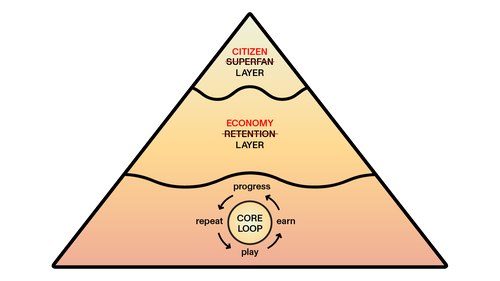New Web3 Game Design Pyramid

Game economies and game design go hand-in-hand. There are several game design frameworks I like to apply when evaluating web3 games. One favorite is Nicholas Lovell’s pyramid for free-to-play (F2P) game design.

Traditional free-to-play game design pyramid
There are three layers: core loop, retention, and SuperFan.
The core loop is what makes the game “fun”. The retention layer is what keeps players playing. The SuperFan is the whale, the guild leader, the top e-sports player… you know who you are.
What makes a game “fun” to begin with?
Players have fun when they feel the following emotions:
(1) Love ❤️
(2) Power 👑
(3) Wealth 💰
Note: Credit to Mark Otero of Azra Games for the initial core loop framework.
Players build friendships with their guild mates. Players gain power through leveling up or improving their headshot skills. Players have fun accumulating assets like skins or items. This is the basic thing that your player does over and over again.

The retention system is what get players coming back. It can be as simple as getting the highest score or earning experience points to level up. The battle pass is an example of the retention system. Players earn additional rewards based on fulfilling daily missions which can be redeemed for in-game items.
Finally, we come to the SuperFans. The game has officially become a hobby — a regular part of the players’ everyday lives. They are comfortable spending time and money for entertainment. This phase is highly social and competitive; thus where the biggest spending happens. Guilds and leagues are often seen in games that reach this state.

What makes web3 games different?
Let’s go back to what makes games fun. Up until this point, the games were highly optimized to create fun core loops through love and power. So far, players’ accumulation of real wealth in a game has been extremely inefficient. A YouTuber regularly posts about their favorite game, but the platform takes 45% cut. People sell skins or in-game currencies in the gray market.
The current generation of play-to-earn (P2E) games just expands monetization among the SuperFans by enabling additional ways for the whales to spend money. While whales can be very lucrative, there are only so many of them. Thus, it limits the project’s total addressable market.
The new Web3 gaming winners will be those that 1) develop fun core loops activating love, power AND wealth; 2) adapt retention systems into sustainable economies; 3) design for Citizens rather than SuperFans.
This is the new Web3 Game Design Pyramid.

With blockchain technology, the game must achieve love, power and wealth in the same core loop. This is where it starts for any play and earn game hoping to make it. The closest analogs from the traditional gaming world are free-to-play, skill-based or gambling games as starting points.
Shift from retention to economic systems
A retention system gives players a reason to repeat the core loop, but players do not have an expectation of extracting value. Now that wealth can be built as an efficient core loop, game retention systems will have to evolve into fully-fledged economies.
An economy is a system of inter-related production, consumption and exchange activities that aid in determining how scarce resources are allocated. The production and consumption of goods and services are used to fulfill the need of those (a.k.a. Players) living and operating in it. Up until this point, players have only spent money in games without any expectation to be able to extract the money. This is why games have only been hobbies until this point. Now that real value extraction is possible, the game needs to balance both ends.
SuperFans becoming Citizens
SuperFans play games primarily as a hobby. Citizens want to contribute to society. Economies make society possible by providing the goods and services it needs to function and prosper.
Citizens participate in economies if they feel they can make meaningful social and economic interactions from Day 1. Not only do play and earn games have to foster friendships and friendly competition, they must prioritize ways to stimulate trading, create jobs, build markets for resources and many more to bring prosperity for all the game’s citizens.
What’s next?
It’s an exciting time to be in games and crypto. More and more gaming veterans are coming into the space, and the teams and game pitches are exponentially better than six months ago. Although we will see a lot of failures, I strongly believe we will see a new game studio become the Supercell, Riot or Blizzard of web3 in the next few years. I’ve only been a full-time operator in crypto for two months, and I’ve already learned so much.
Have you found this post helpful? Should I write more like this? Love to hear your feedback.